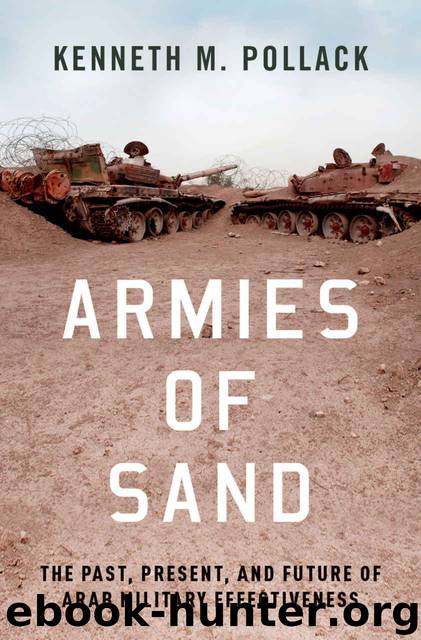Armies of Sand by Pollack Kenneth M

Author:Pollack, Kenneth M.
Language: eng
Format: epub
Publisher: Oxford University Press
Published: 2018-12-05T16:00:00+00:00
No Judgments
Because it is culture—dominant or national, local or subcultural, institutional or organizational—that determines which societies, or which groups within societies, generate the largest numbers of men (and increasingly, women) with the skills needed for success in the dominant mode of warfare of the time, culture can obviously play a critical role in determining military fortunes. However, none of this should be seen as applauding one culture or denigrating another. Cultures, especially the cultures of nations and other societies that lie beyond mere military organizations, emphasize some traits and behavioral patterns over others based on the circumstances of the society, both physical and historical. The traits and patterns of behavior the culture favors make sense for its society in that place at that time.
In other words, culture can grant some advantages to a society in certain activities where two societies are competing, but that does not mean that one is superior to the other except in that narrow area of competition. Remembering both the Mongols and the Romans is helpful here. The Roman empire that stretched from the second century b.c. to the fifth century a.d. and the Mongol empire of the thirteenth century a.d. were both phenomenal conquerors. Both invaded numerous neighboring states and crushed their armies, fought vast wars, and were consistently victorious. In both cases, there were cultural aspects of their societies that were critical to their military successes. Both societies contained cultural tendencies that allowed them to generate much greater military power than their neighbors—whether it was the tactical excellence of the Roman legion or the Mongol archer, or the strategic ability of each society to keep generating large numbers of both. Both were often superior to the societies they conquered in this narrow aspect of human activity: warfare. That narrow superiority turned out to be extremely important, especially to peoples conquered by these empires, such as the Carthaginians and Chinese.
However, it does not follow that Roman or Mongol society was superior in general, or in every way, or in any other way other than war-making to other societies, even to those societies they conquered. Culture encompasses a vast range of traits related to an equally vast number of human activities. Just because the Mongols were better than the thirteenth-century Chinese at war-making does not mean that they were superior in any other way. The Chinese generally believed they were far more sophisticated, creative, and knowledgeable than the Mongols. They may well have been, suggesting their own culture was superior to that of the Mongols in producing many other desirable skills. That sophistication did not save them from conquest because the Mongols were superior in the one area that mattered when they clashed: war-making. (Had the Mongols and Chinese competed in poetry or pottery rather than killing, the outcome probably would have been very different.) But their competition was military, and the Mongols proved far superior in that one area. Similar arguments could be made about the relative advantages of Roman and Greek cultures—arguments in which many Romans would have agreed on the superiority of Greek philosophy, sculpture, rhetoric, etc.
Download
This site does not store any files on its server. We only index and link to content provided by other sites. Please contact the content providers to delete copyright contents if any and email us, we'll remove relevant links or contents immediately.
| Arms Control | Diplomacy |
| Security | Trades & Tariffs |
| Treaties | African |
| Asian | Australian & Oceanian |
| Canadian | Caribbean & Latin American |
| European | Middle Eastern |
| Russian & Former Soviet Union |
The Secret History by Donna Tartt(18849)
The Social Justice Warrior Handbook by Lisa De Pasquale(12142)
Thirteen Reasons Why by Jay Asher(8796)
This Is How You Lose Her by Junot Diaz(6794)
Weapons of Math Destruction by Cathy O'Neil(6146)
Zero to One by Peter Thiel(5686)
Beartown by Fredrik Backman(5599)
The Myth of the Strong Leader by Archie Brown(5425)
The Fire Next Time by James Baldwin(5249)
How Democracies Die by Steven Levitsky & Daniel Ziblatt(5128)
Promise Me, Dad by Joe Biden(5087)
Stone's Rules by Roger Stone(5026)
A Higher Loyalty: Truth, Lies, and Leadership by James Comey(4845)
100 Deadly Skills by Clint Emerson(4840)
Rise and Kill First by Ronen Bergman(4704)
Secrecy World by Jake Bernstein(4646)
The David Icke Guide to the Global Conspiracy (and how to end it) by David Icke(4625)
The Farm by Tom Rob Smith(4438)
The Doomsday Machine by Daniel Ellsberg(4416)
